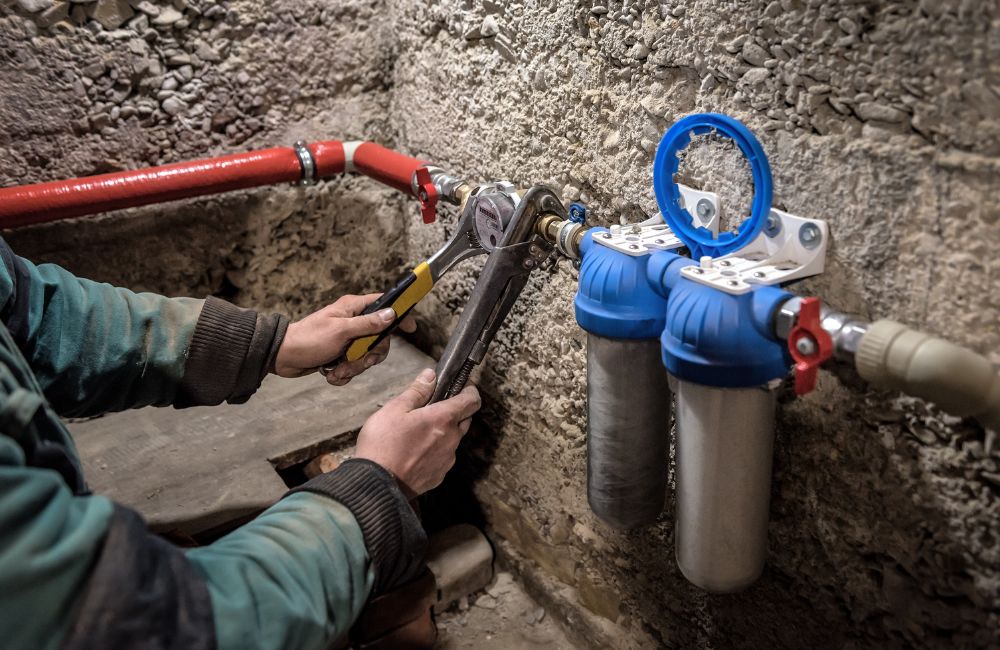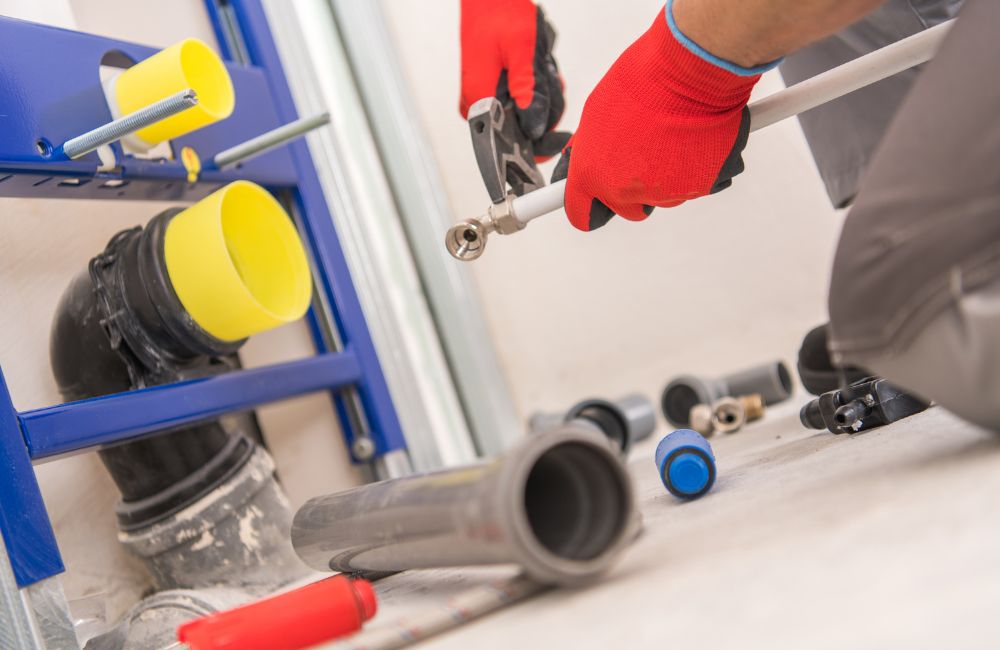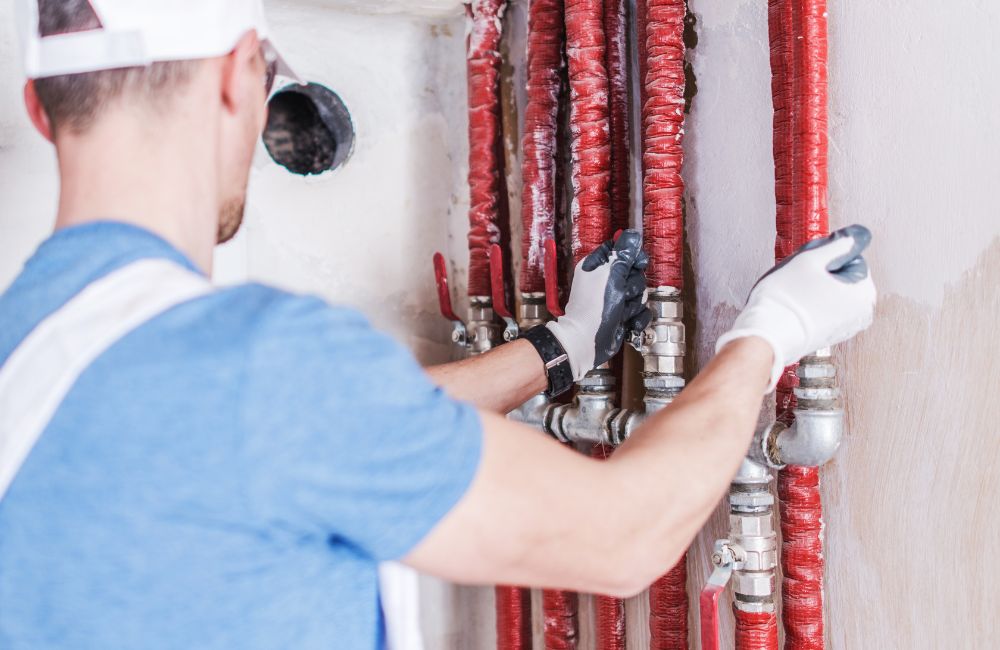Experiencing low water pressure can be incredibly frustrating. Simple tasks like showering, washing dishes, or even watering the garden can become difficult and time-consuming. Addressing low water pressure is essential for maintaining home comfort and efficiency. Here, we’ll explore seven common causes of low water pressure and explain how a professional plumbing company in Torrington, CT, can resolve these issues.
Table of Contents
Table of Contents
Key Takeaways
What is Water Pressure?
7 Common Causes of Low Water Pressure
1. Clogged Pipes
2. Faulty Pressure Regulator
3. Leaking Pipes
4. Corroded Plumbing
5. Municipal Water Supply Issues
6. Valve Issues
7. Water Demand Exceeds Supply
Preventative Measures
When to Contact a Plumbing Company
Frequently Asked Questions
| Key Takeaways Water pressure, measured in PSI, is crucial for efficient appliance functioning and daily activities, ideally ranging between 30-80 PSI. Low water pressure can stem from clogged pipes, faulty pressure regulators, leaking pipes, corroded plumbing, municipal supply issues, valve problems, and high water demand. A professional plumbing company can address these issues through methods like cleaning or replacing pipes, inspecting and replacing pressure regulators, repairing leaks, and installing water pressure boosters. Persistent low water pressure, unusual noises, discolored water, frequent clogs, and visible water damage are signs that professional help is needed. Ensure the plumbing company has positive reviews, proper credentials, experience, and specializations, and offers clear communication, emergency services, and warranties. |
What is Water Pressure?
Water pressure is the force that pushes water through your pipes and out of your taps, and it is measured in pounds per square inch (PSI). For most homes, normal water pressure ranges between 30 and 80 PSI, ensuring a steady and adequate flow of water from your taps and showers.
Consistent water pressure is crucial for the efficient functioning of appliances such as washing machines, dishwashers, and water heaters. It also provides a pleasant experience when using faucets and showers.
When the water pressure drops below this ideal range, it can affect daily activities and the performance of these appliances, indicating a potential issue with the plumbing system.

7 Common Causes of Low Water Pressure
Low water pressure can be a frustrating issue, disrupting daily routines and affecting the efficiency of household appliances. Here are seven common causes of low water pressure and how a plumbing company can address them.
1. Clogged Pipes
Mineral deposits and debris can accumulate inside pipes over time, leading to clogs that restrict water flow. Common indicators of clogged pipes include reduced water flow from taps and slow-filling appliances.
Causes
- Mineral Buildup: Hard water, which contains high levels of minerals such as calcium and magnesium, can leave deposits inside pipes over time.
- Debris Accumulation: Foreign objects, such as hair, grease, and soap scum, can accumulate in pipes, causing blockages.
- Corrosion: In older plumbing systems, pipes can corrode and deteriorate, leading to blockages and reduced water flow.
Signs
- Reduced Water Flow: Noticeable decrease in water flow from faucets and showers.
- Slow-Filling Appliances: Appliances such as washing machines and dishwashers taking longer to fill.
- Gurgling Sounds: Unusual sounds coming from the pipes, indicating a blockage.
Solutions
- Professional Cleaning: A plumbing company can use specialized tools, such as hydro jetting, to clean the pipes and remove blockages.
- Pipe Replacement: In severe cases, a plumbing company may need to replace sections of the pipes that are heavily clogged or corroded.
2. Faulty Pressure Regulator
A pressure regulator controls the water pressure entering your home. If it fails, you might experience low water pressure. Signs of a faulty pressure regulator include inconsistent water pressure throughout the house.
Causes
- Wear and Tear: Over time, pressure regulators can wear out and become less effective.
- Manufacturing Defects: Occasionally, pressure regulators may have defects that cause them to fail prematurely.
- Improper Installation: Incorrect installation can lead to malfunctioning of the pressure regulator.
Signs
- Inconsistent Pressure: Noticeable fluctuations in water pressure throughout the house.
- Water Hammer: Loud banging noises in the pipes when water is turned on or off, indicating pressure issues.
- Low Water Flow: Reduced water flow from all faucets and fixtures.
Solutions
- Inspection and Diagnosis: A plumbing company can inspect the pressure regulator to determine if it is functioning correctly.
- Replacement: If the pressure regulator is faulty, a plumbing company can replace it with a new one to restore normal water pressure.
3. Leaking Pipes
The average U.S. household leaks waste over 10,000 gallons of water each year. Leaks in your plumbing system can significantly reduce water pressure. You might notice damp spots on walls or ceilings and an unexplained increase in your water bill.
Causes
- Corrosion: Pipes can corrode over time, leading to small leaks that reduce water pressure.
- Physical Damage: Accidental damage from construction work or shifting foundations can cause pipes to leak.
- Loose Connections: Joints and connections in the plumbing system can become loose, leading to leaks.
Signs
- Damp Spots: Visible damp spots on walls, ceilings, or floors, indicate a hidden leak.
- Increased Water Bills: Unexplained increase in water bills due to water wastage from leaks.
- Mold and Mildew: Growth of mold and mildew in areas with hidden leaks.
Solutions
- Leak Detection: A plumbing company in Torrington, CT, can use advanced leak detection methods, such as thermal imaging and acoustic sensors, to locate hidden leaks.
- Pipe Repair: Once the leaks are located, a plumbing company can repair or replace the damaged sections of the pipes to restore water pressure.
4. Corroded Plumbing
Older pipes, especially those made of galvanized steel, can corrode over time, leading to blockages and low water pressure. Signs of corroded plumbing include discolored water and frequent leaks.
Causes
- Galvanized Steel Pipes: Older homes often have galvanized steel pipes that are prone to corrosion.
- Chemical Reactions: Chemical reactions between the water and the pipe material can cause corrosion.
- Aging: Over time, all plumbing materials can deteriorate and corrode.
Signs
- Discolored Water: Brown or yellow water coming from the taps, indicating rust and corrosion in the pipes.
- Frequent Leaks: Persistent leaks and water damage due to corroded pipes.
- Low Water Pressure: Gradual decrease in water pressure as the pipes become clogged with corrosion.
Solutions
- Pipe Inspection: A plumbing company can inspect the pipes to assess the extent of the corrosion.
- Pipe Replacement: In cases of severe corrosion, a plumbing company can replace the old pipes with new materials such as copper or PEX to improve water flow and pressure.
5. Municipal Water Supply Issues
Sometimes, the problem lies with the municipal water supply rather than your home’s plumbing. If your neighbors also experience low water pressure, this might be the cause.
Causes
- Water Main Breaks: Breaks or leaks in the municipal water mains can reduce water pressure in the entire neighborhood.
- High Demand: During peak usage times, the municipal supply may struggle to meet the high demand, leading to low water pressure.
- Maintenance Work: Ongoing maintenance or repairs by the municipal water supply can temporarily reduce water pressure.
Signs
- Neighborhood-Wide Issue: Low water pressure experienced by multiple households in the same area.
- Public Notifications: Announcements or notices from the municipal water supply about maintenance or repairs.
- Sudden Pressure Drop: Sudden and unexplained drop in water pressure affecting the entire household.
Solutions
- Confirmation: A plumbing company can confirm if the issue is with the municipal water supply by conducting tests and checking for public notices.
- Interim Solutions: While waiting for the municipal issue to be resolved, a plumbing company can suggest temporary measures, such as installing a water pressure booster.
6. Valve Issues
Shut-off valves and pressure-reducing valves play crucial roles in managing water flow. If these valves malfunction, they can cause low water pressure. Symptoms include inconsistent pressure and difficulty turning taps on or off.
Causes
- Wear and Tear: Over time, valves can wear out and become less effective.
- Improper Installation: Incorrect installation of valves can lead to malfunctions.
- Blockages: Valves can become blocked with debris or mineral deposits.
Signs
- Inconsistent Pressure: Fluctuating water pressure throughout the house.
- Difficulty Operating Taps: Taps that are hard to turn on or off, indicating valve issues.
- Unusual Noises: Whistling or banging sounds when water is turned on or off, suggesting valve problems.
Solutions
- Valve Inspection: A plumbing company can inspect the valves to check for wear, blockages, or improper installation.
- Valve Repair or Replacement: Depending on the issue, a plumbing company can repair or replace faulty valves to restore normal water pressure.
7. Water Demand Exceeds Supply
Using multiple water fixtures simultaneously can cause a drop in water pressure. This is common in homes with high water usage during peak times.
Causes
- Simultaneous Usage: Multiple taps, showers, and appliances running at the same time can exceed the capacity of the plumbing system.
- Undersized Pipes: Pipes that are too small to handle the household’s water demand can cause pressure drops.
- Water Distribution Issues: Inefficient water distribution within the plumbing system can lead to pressure imbalances.
Signs
- Pressure Drops During High Usage: Noticeable drop in water pressure when multiple fixtures are used simultaneously.
- Inconsistent Pressure: Fluctuating water pressure depending on the time of day and water usage.
- Slow-Filling Appliances: Appliances take longer to fill during peak usage times.
Solutions
- Water Pressure Booster: A plumbing company can install a water pressure booster to maintain consistent pressure even during high demand.
- Pipe Upgrades: In some cases, upgrading to larger pipes can help manage higher water demand.
- Optimized Distribution: A plumbing company can reconfigure the plumbing system to ensure efficient water distribution.
Preventative Measures
To avoid low water pressure issues, regular maintenance is key. Here are some tips:
- Conduct Regular Inspections: Schedule regular inspections with a professional plumbing company to identify and address potential issues before they become major problems.
- Perform DIY Maintenance: Simple maintenance tasks, such as cleaning faucet aerators and showerheads, can help prevent mineral buildup and maintain proper water flow.
- Install Water Softener: If you have hard water, consider installing a water softener to reduce mineral deposits in your pipes. A plumbing company can help with the installation and maintenance of a water softener.
- Address Issues Immediately: Address minor leaks and plumbing issues promptly to prevent them from escalating into major problems. A plumbing company can provide timely repairs to keep your plumbing system in good condition.
When to Contact a Plumbing Company
Knowing when to seek professional help is essential for maintaining an efficient and problem-free plumbing system.
When to Call a Plumbing Company
- Persistent Low Water Pressure: If you’ve tried basic troubleshooting and still experience low water pressure, it’s time to call a plumbing company.
- Unusual Noises: Whistling, banging, or gurgling sounds in your pipes indicate potential issues that require professional attention.
- Discolored Water: Brown or yellow water coming from your taps can signal corrosion or other problems in your plumbing system.
- Slow Drains: If your sinks or bathtubs are draining slowly despite using common unclogging methods, it could be a sign of a more serious blockage that a plumbing company can address.
- Visible Water Damage: Signs of water damage, such as damp spots, mold, or mildew on walls and ceilings, can indicate leaking pipes that need immediate professional attention.
- Decreased Water Quality: If you notice a change in the taste, smell, or color of your water, it could be due to contamination or corrosion in your pipes, necessitating a plumbing company’s intervention.
How to Choose a Reputable Plumbing Company
- Check Reviews: Look for a plumbing company with positive customer reviews and testimonials. Online platforms like Google, Yelp, and the Better Business Bureau can provide valuable insights into customer experiences.
- Verify Credentials: Ensure the plumbing company is licensed, insured, and has experienced technicians. This guarantees that the company meets industry standards and can provide professional service.
- Request Estimates: Get quotes from multiple plumbing companies to compare prices and services. This helps you understand the market rate and ensures you are not overpaying for services.
- Check for Specializations: Some plumbing companies specialize in certain areas, such as residential plumbing, commercial plumbing, or emergency services. Ensure the company you choose has expertise in the specific services you need.
- Confirm Availability: Ensure the plumbing company offers emergency services or has flexible scheduling options to accommodate urgent issues. A reliable company should be able to respond promptly to emergencies.
- Look for Warranties and Guarantees: Reputable plumbing companies often offer warranties or guarantees on their work. This provides peace of mind that they stand behind the quality of their services.
- Evaluate Customer Service: Pay attention to the customer service you receive when contacting the plumbing company. Friendly, professional, and knowledgeable staff are indicators of a company that values its customers.
What to Expect from a Professional Plumbing Company
- Thorough Inspection: A professional plumbing company will conduct a comprehensive inspection to identify the root cause of low water pressure.
- Detailed Diagnosis: The plumbing company will provide a clear explanation of the issues and recommended solutions.
- Effective Solutions: The plumbing company will offer effective solutions to restore normal water pressure, whether it’s cleaning clogged pipes, replacing faulty components, or upgrading the plumbing system.
- Preventative Advice: A professional plumbing company can also provide advice on preventative measures to maintain proper water pressure and avoid future issues.

Frequently Asked Questions
Who is responsible for changing a water pressure regulator?
Typically, the homeowner is responsible for maintaining and replacing the water pressure regulator in their home. However, it is often advisable to hire a professional plumbing company to handle this task. A licensed plumber from a reputable plumbing company has the expertise and tools required to replace the regulator safely and effectively, ensuring your home’s water pressure is properly regulated.
What is the life expectancy of a water pressure regulator?
The life expectancy of a water pressure regulator is usually between 10 to 15 years. However, this can vary depending on the quality of the regulator, the water conditions, and the overall maintenance of the plumbing system. Regular inspections by a plumbing company can help extend the life of your pressure regulator and ensure it is functioning correctly.
How do you troubleshoot water pressure problems?
To troubleshoot water pressure problems, first check multiple fixtures to determine if the low pressure is affecting all fixtures or just specific ones. Inspect the pressure regulator to ensure it is set correctly and functioning. Look for leaks by examining pipes and connections for visible leaks or damp spots. Clean aerators and showerheads, as mineral buildup can clog these, reducing water pressure. Check the main shut-off valve to make sure it is fully open. If the issue persists, contact a professional plumbing company to conduct a thorough inspection and identify the root cause.
Can I fix my water pressure?
While some minor water pressure issues can be addressed by homeowners, such as cleaning faucet aerators or checking the main shut-off valve, it is generally recommended to contact a professional plumbing company for more complex problems. A plumbing company has the expertise and equipment to diagnose and fix water pressure issues safely and efficiently.
How do I reset my water pressure?
To reset your water pressure, first turn off the main water supply by locating and turning off the main water valve. Then, drain the system by opening all faucets and flushing toilets to drain the remaining water from the pipes. Adjust the pressure regulator using a wrench to set it to the desired PSI, typically between 40-60 PSI for residential homes. Slowly turn the main water valve back on and check the water pressure by turning on faucets to ensure it is at the desired level. If you are unsure or the pressure does not reset, contact a plumbing company for assistance.

Contact L&P Plumbing for Expert Water Pressure Solutions
If you’re experiencing low water pressure in your home, don’t wait for the problem to worsen. Contact L&P Plumbing today for expert diagnosis and solutions. Our team of professionals is dedicated to serving Torrington, CT, residents with top-quality plumbing services.
Ensure your home’s plumbing system runs smoothly. Call L&P Plumbing in Torrington, CT, now!

